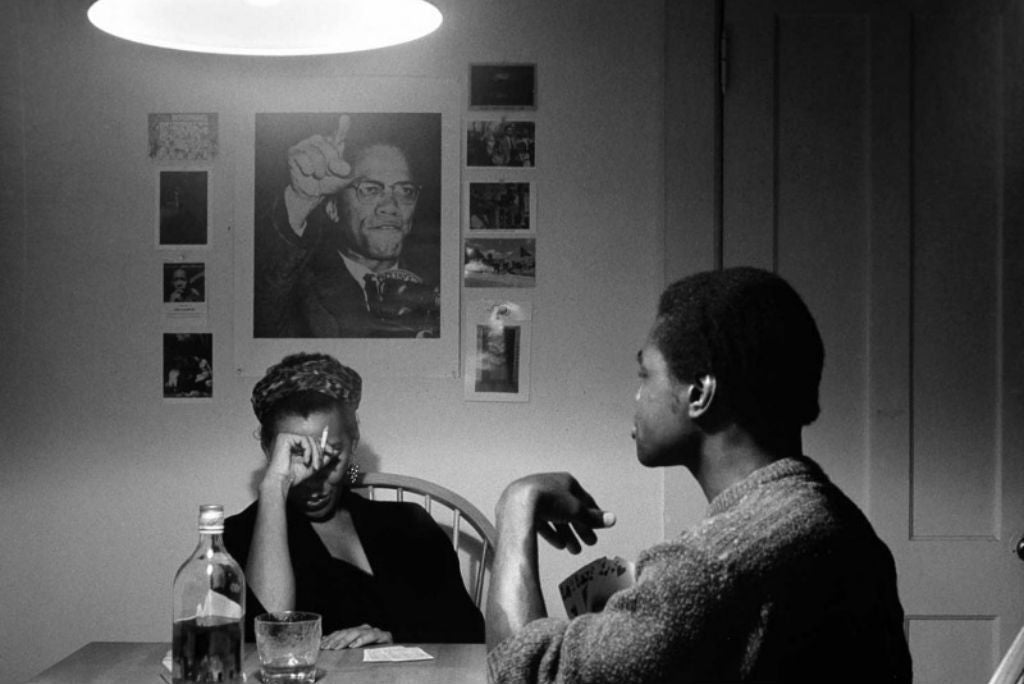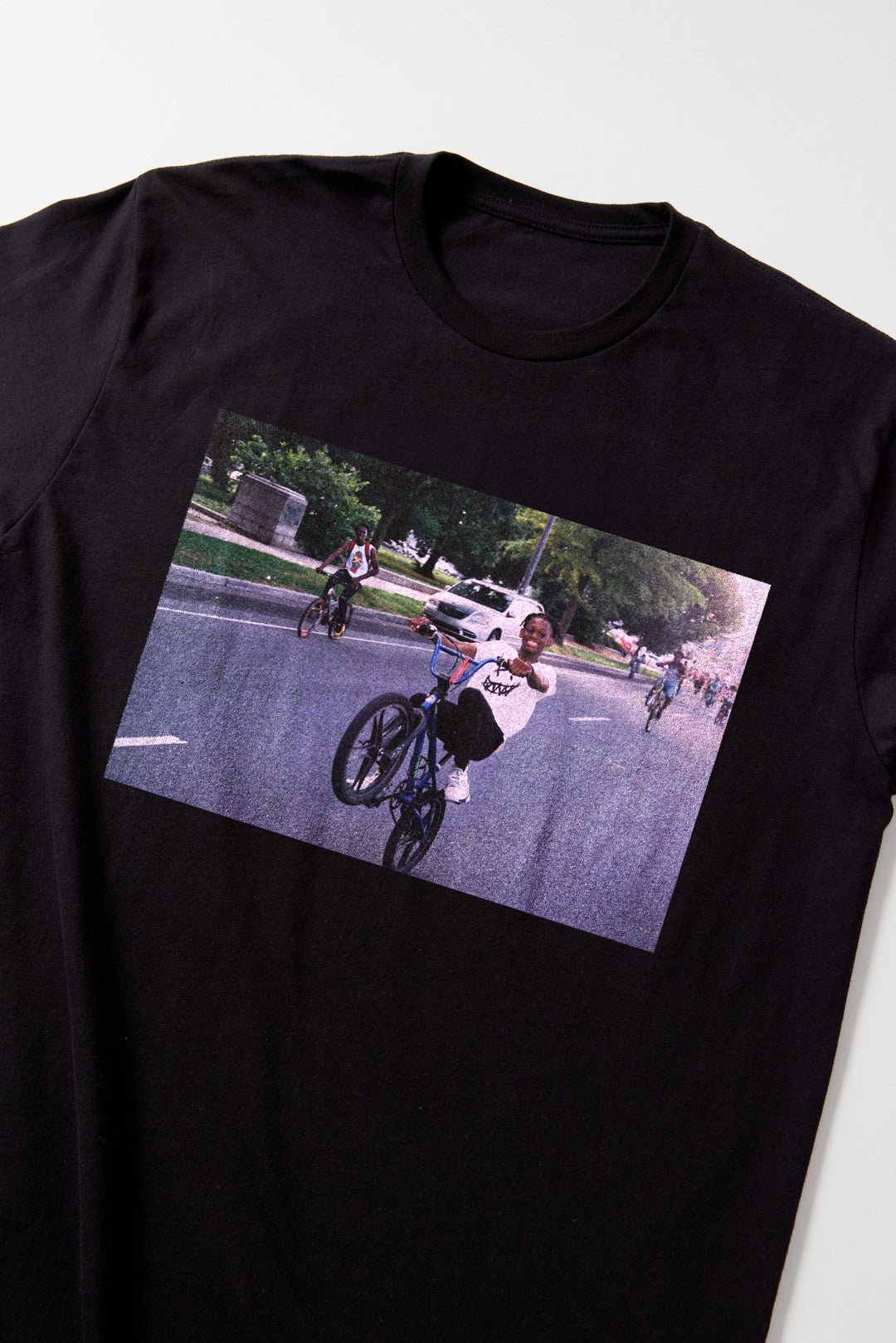
Bleeding Walls: How We Hang Black Art in Our Homes
BY JOÉL LEON | PHOTO BY CARRIE MAE WEEMS
My mother hangs pictures on her Bronx apartment walls of Black art and well known Black figures as if she knows them, as if she drew them herself, the pride she feels for the pieces.
In the bathroom are art pieces not for museums, but for Black home love ritual practitioners: pictures of Black men dressed as kings, with Black women queens holding on to the veiny brown muscles of their lovers, with poetry about love and needs and wants and the art of shouldering, of carrying melanin for and with the one you have been chosen to make life with; another one of a Black girl, hair like a hundred militants posing for a photo, more poetry underneath, this time, something more along the lines of living your life for you. There may be an air of goat soup scraping the cupboards, faint aromas of Dominica and ginger beer, coke and Rum stained glasses. In the kitchen, the magnets coloring the fridge, a collage of traveled islands, wedding dates, to-do’s, ghosts dancing near the stove, waiting for bacalao and salmon cakes. There are pictures of the Obama family, of Mandela, adorning the same off-white walls filled with smiling nephews, cooing nieces, cooling cousins, older brothers — insinuating the Obama’s and Mandela’s are kin to the Daniels’ and Warrington’s. My mother’s home was, and still is, serving itself as a living, breathing art space. But, her home was no different than any of the other flavors that colored the walls of the spaces my people would call “home”. Art, you see, lived anywhere arms would welcome it to.
The Jamaican spot on Boston Rd., there you can get a small styrofoam container of cabbage, peas, and rice, goat meat or jerk chicken, for $6. The skinny one is rude but smiles, and you gotta ask for extra jerk sauce, because the rude skinny one don’t like to put no more jerk sauce on the rice, too. You gotta ask for it. In the Jamaican spot with the big fan, are posters of sound system clashes, posters for church cookouts, posters of dancehall parties in forgotten areas of Brooklyn and Queens, posters of Mandela and Obama. The big fan blows the twang of the peoples’ language to the front, the flavors of stewed chicken and cabbage patty-caking the shadows. The sounds of mouths wide open, acting as casting nets for the oxtails and the curried goat and dumplings.They talk, the people and the flavors, like they are yelling, yelling like they are fucking, smiling like they are eating, eating like they fucking again. Because Jamaicans eat and fuck with style and an abrasiveness only Caribbean kinfolk could understand.
In the Jamaican spot with the big fan, are posters of sound system clashes, posters for church cookouts, posters of dancehall parties in forgotten areas of Brooklyn and Queens, posters of Mandela and Obama.
Black folks have made it a tradition, sharing the walls of homes with other Black famous folks; it is a rite of passage to be given the privilege of holding space with daughters, one-year-old birthday parties, cruise ship pictures, Sears family packaged shots, high-school senior year photos and blown up jail pose polaroids. This tradition also includes the art you get from the homie on Fordham Rd., who has a table set up for CD’s and scents and other items available for purchase reasonably priced in the $5-$10 range that also includes: watches, phone accessories, incense, earrings, and bracelets. There are no registers or card scanners. There may be a knapsack involved where the seller keeps his change or a box for the same. There is no receipt, only your memory of a purchase, the remnants of an exchange, the frames of your pictures, the boxes or plastic bags for your carrying pleasure.
Maybe it is not so much a Black thing in the same way Black on Black crime is not a Black thing, but a proximity thing — that, by proxy, by the sheer closeness of bodies, that we put pictures painted, pawned, or photographed by the likes of the ones sharing the slick skin of the ones being captured, that we tape them, we nail them, we hang them, like nooses, like crucifix to our walls, serving as reverence, as remembrance, for what their Blackness means to us, for us. Teeny boppers, Black and White, would go through their favorite magazines, looking for posters of their favorite Backstreet Boy, N’Sync member, every NKOTB, and New Edition photo, every One Direction interview. Black teens walls now know the feel of a Drake against their paint, OVO Sounds and Young Thug, Travis Scott action figurines; alas there are no more Vibe pages to pull sheets from, no classic XXL covers to laminate.
My walls would change. They were once shared walls, mainly my older brother’s walls, walls of Kid N’ Play or EPMD, Rakim and whoever graced Right On covers. Later it would be The Source and Vibe covers, the Jay Z’s and B.I.G.’s and Nas’ of the world. When I was old enough to have a space and was learning teenage boy things, Black Men Magazine pages would share pieces of paint with XXL photospreads, Stacey Dash alongside Foxy Brown, next to M.O.P., Big Pun beside Halle Berry. The walls served as reflections of my world: women and Hip-Hop.
There is context, meaning behind why our walls bend and bleed the way they do, never yielding to time or circumstance, living off of lead, and love.
As a teenager, I spent time and wall space attempting to find my own version of Lauryn Hill in the hallways of the middle school. I hoped she would find herself near me in a cypher, hair wrapped, brown skinned hands swaying, spittle flying while beats shook and mouths made boombox sounds fly high. The first time rubbing shoulders to that was seeing Lauryn in Brooklyn - under rain showers with a younger Suri, who was not a sister with a headwrap, but a White girl with old soul distinctions. We held and sang and raised hands and hips. We watched bass lines and rhythms and eat clouds and beef patties and I went home and made love to a wall. Walls became journals, the gateways to the soul experience, the mirror of my imagination. On a wall with Vanessa William Ebony profiles, I could take my feelings and tape them above my bed, near the headrest. The walls became the canvas, serving as the portal for the dreams and fantasies of a 13-year-old hip-hop nerd boy.
The digital era has invited replicas of the pieces that once saturated the living room’s with the plastic on the couches - wall frames for Snapchat, 4x4’s biting dust for slick-to-share’s. Our “feeds”, our “walls” are cyber. Our home walls are authored Ikea framed quotes, like “Good things await” in Sanskrit, or pop art from Kickstarter campaigns. We hang our artsy friends charcoal explorations, or our latest “Drink n’ Draw” from *insert cool hipster date thing to do* experiments on living rooms, fresh paint smell taking in the rooms.You can almost see the teething of the Williamsburgs, the Portlands, the reformed seedy areas of pop culture, brewing in the corners of bistros decked out with Warhol faux art. If you are watching close enough, you will see the steely resolve of gentrification
My physical walls are bare, now. I feel too old for the nostalgia of it all. But they are bare, not from a lack of attempt, but more so because the things that once adorned and washed the chipped paint, now live in archives stored in my remembrances - of embraces and whispers and kisses. Not like the walls I still see sometimes, framed in the back of my mind; walls adorned with the tales of yesteryears of the women I loved and the friends I lost -older Dominican mujers, viejas with vibrant bones and broken English, with pictures of Trujillo under a tank or grenade shelling splattered above plastic covered couches — them’s the one’s still lighting candles for Catholicism for their private altars. These women see spirits in smoke and sex and pray 20 times a day, letting the sin out of their panties with a twist of their hands and a shift of the water waiting in their waists. There is context, meaning behind why our walls bend and bleed the way they do, never yielding to time or circumstance, living off of lead, and love.
And yet, the bleeding never stops. Because these pieces, this art, those images, are still burning holes in hearts. Images of Black bodies hurled off of buses, of brutality by batons, of death by body cam. These are the pieces I have watched my mother build walls for; the pieces I have seen old Caribbean women make soursop around, cook curried goat meat and stewed peas, backs curled over steam and flavors and yellow pepper sauce. Refrigerator magnets from forgotten coasts and well-known family functions, visits to islands, the sounds stuck in the rooms with the Mandela newspaper clippings and Martin Luther King, Jr. and Black Jesus photos, quotes hung to the tableaus of art like Bible verses. There is a history in those if you are willing to pay the fee for attention, if you are willing.

